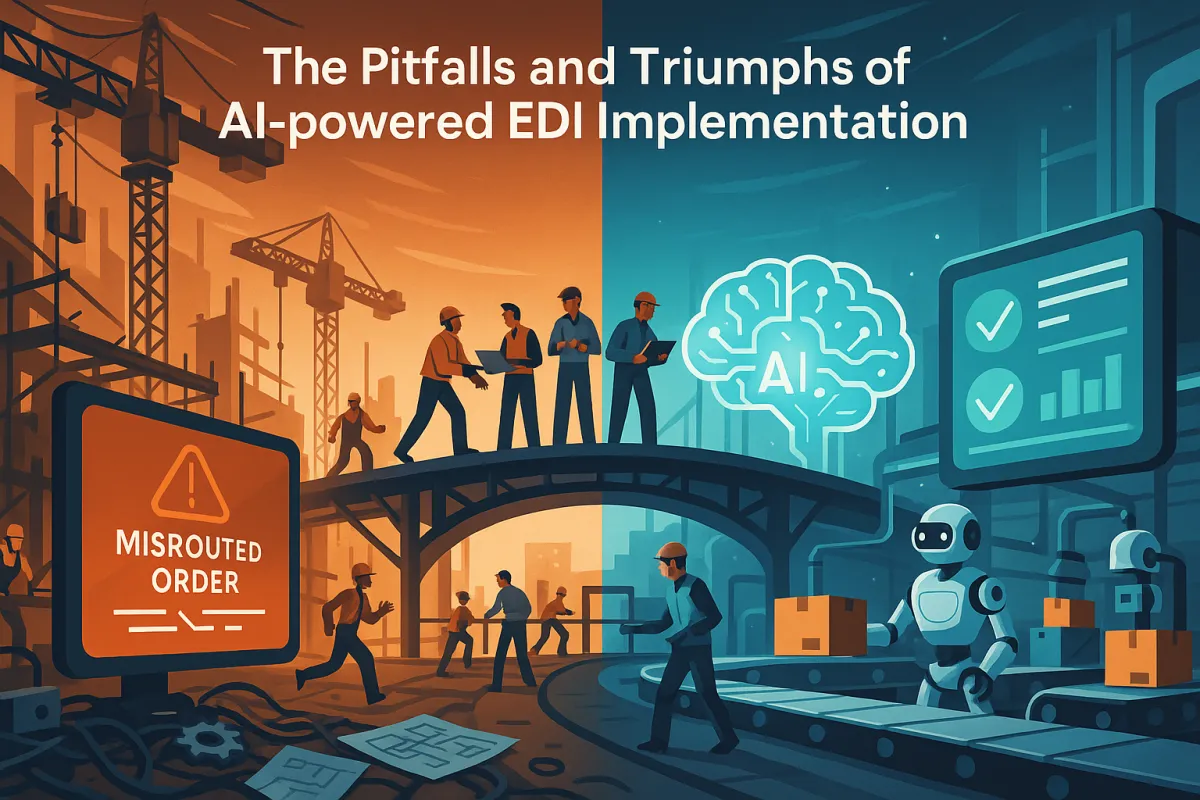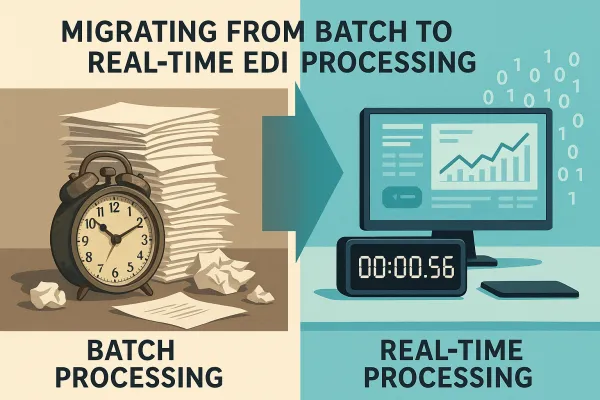The 7 Critical AI-Powered EDI Implementation Mistakes That Cost Companies Millions (And How to Avoid Them in 2025)

Your AI-powered EDI automation project just failed spectacularly. Nearly half of companies report their AI initiatives running behind schedule or over budget, and AI development costs can range from $50k to $500k+ depending on complexity. The promise of automated data mapping, predictive analytics, and intelligent error detection sounds compelling, but the reality hits differently when your system starts misrouting purchase orders or your compliance team discovers the AI flagged legitimate transactions as fraud.
In 2025, EDI has evolved beyond simple digital document exchange to become a foundational enabler of enterprise automation and artificial intelligence. The potential benefits are undeniable: automated data mapping that reduces setup time, proactive error detection, and predictive analytics for forecasting shipment delays or demand surges. But here's what most implementation guides won't tell you: a rushed AI-EDI implementation leads to failed integrations, data inconsistencies, and requires auditing current systems with clear objectives through a controlled process.
After analyzing dozens of AI EDI implementation challenges across manufacturers, retailers, and logistics companies, seven critical mistakes consistently emerge. Understanding these pitfalls—and their solutions—can save you months of delays and hundreds of thousands in rework costs.
Mistake #1: Rushing Implementation Without Proper Data Quality Assessment
Your AI model is only as good as the data you feed it. AI needs clean, structured data to work effectively, but most companies discover their data quality issues only after deployment starts producing bizarre results.
Picture this: You've invested six months implementing an AI system to automatically map product codes between your ERP and trading partners. Three weeks after go-live, your procurement team reports that 40% of orders are being rejected due to invalid item numbers. The AI learned from historical data that included discontinued products, duplicate entries, and legacy codes from a system migration five years ago.
AI can identify and correct errors in EDI data using machine learning algorithms to detect anomalies and inconsistencies in real-time, but garbage in means garbage out. The solution starts before you touch any AI technology.
Solution Framework:
- Conduct a comprehensive data audit covering the last 24 months of EDI transactions
- Identify data quality metrics: completeness, accuracy, consistency, and timeliness
- Establish baseline measurements and set improvement targets
- Implement data cleansing processes before AI training begins
- Create ongoing data validation rules that work alongside your AI system
Leading TMS providers like MercuryGate and modern platforms including Cargoson have built data quality checks into their AI implementations from day one. They understand that improved data quality directly translates to more accurate B2B transactions and better business relationships.
Mistake #2: Underestimating Legacy System Integration Complexity
You're running EDI on systems from 2018, maybe earlier. Your IT team assures you the integration will be "straightforward" because the vendor provides APIs. Six months later, you're still building middleware to translate between data formats that your legacy system can't natively handle.
The key challenges in AI-powered EDI data mapping relate to the underlying complexity of EDI and the semantic data models used by different organizations. Your "Customer_ID" field might mean something completely different from your supplier's "CLIENT_CODE," and the same term can be interpreted differently by different organizations.
Legacy systems weren't designed with AI integration in mind. They lack the APIs, data structures, and processing capabilities that modern AI systems expect. This creates a technical debt that compounds every day your AI implementation is delayed.
Staged Migration Approach:
- Phase 1: Establish API connectivity and data flow validation
- Phase 2: Implement middleware for format translation and error handling
- Phase 3: Deploy AI components with human oversight and validation
- Phase 4: Gradual automation increase as confidence grows
Modern platforms like Transporeon and nShift have built their architectures specifically to handle these integration challenges. Cargoson's approach includes pre-built connectors and standard integration patterns that reduce the complexity significantly, but even they require careful planning for legacy system compatibility.
Mistake #3: Inadequate Human-AI Collaboration Framework
Your AI system just automatically approved a $2.3 million purchase order for "industrial widgets" because the quantity and unit price fell within normal parameters. Problem: Your company stopped manufacturing widgets eighteen months ago, and this was clearly a data entry error from a confused supplier.
AI enables proactive error detection and scalable automation, but together these advancements help reduce manual work while minimizing errors and providing real-time visibility. The key word is "help"—not "replace." Successful AI integration requires working with stakeholders and validating AI performance before full deployment.
The most successful AI EDI implementations create configurable automation levels. Critical transactions above certain thresholds require human approval. Unusual patterns trigger review queues. New trading partners start with enhanced validation before moving to automated processing.
Collaboration Framework Elements:
- Define clear escalation rules based on transaction value, partner risk, and data confidence scores
- Create review dashboards that highlight anomalies without overwhelming users
- Establish feedback loops so human corrections improve AI performance
- Build exception handling workflows that route complex cases to appropriate specialists
Oracle TM and SAP TM implementations that succeed focus heavily on this human-AI balance. They recognize that business context and relationship management still require human judgment, while AI excels at pattern recognition and routine processing.
Mistake #4: Ignoring Cost Management and ROI Planning
Your AI EDI project started with a $150,000 budget for the first year. Eighteen months later, you've spent $380,000 and you're still not fully operational. Sound familiar?
AI investments now deliver an average return of 3.5X, with 5% of companies reporting returns as high as 8X, but these results assume successful implementation. AI implementation costs vary dramatically depending on industry, data availability, regulatory requirements, and existing tech infrastructure.
The hidden costs that derail AI EDI projects include data preparation (often 60% of total effort), change management and training, ongoing model maintenance and updates, integration testing with all trading partners, and compliance validation for regulated industries.
Phased Deployment Strategy:
- Start with highest-volume, lowest-risk trading partners
- Focus on one document type (like purchase orders) before expanding
- Use cloud-based platforms to minimize upfront infrastructure costs
- Establish clear ROI metrics and measurement intervals
- Build contingency budgets for data quality remediation
IBM Sterling's enterprise implementations often follow this phased approach, allowing companies to demonstrate value quickly while building organizational confidence. Cargoson's competitive positioning in this space focuses on transparent, subscription-based pricing that scales with usage rather than requiring massive upfront investments.
Mistake #5: Overlooking Security and Compliance Requirements
Your AI system just processed 10,000 transactions containing personal health information without proper HIPAA compliance logging. Your legal team is not happy, and neither is your auditor.
AI helps maintain HIPAA compliance and speeds up claims processing in healthcare, but only when properly configured. Modern EDI systems incorporate end-to-end encryption, multi-factor authentication, and advanced security measures to address rising cyber threats.
AI systems handle vast amounts of sensitive business data, creating new attack vectors and compliance challenges. Your AI models themselves become intellectual property that needs protection. The algorithms that detect patterns in your supply chain data could reveal competitive advantages if compromised.
Security-First Architecture:
- Implement encryption for data at rest, in transit, and during processing
- Create audit trails for all AI decisions and human overrides
- Establish data retention policies that comply with industry regulations
- Build automated compliance monitoring for GDPR, HIPAA, and industry-specific requirements
- Regular security assessments of AI model endpoints and data access
Alpega and E2open have made security a cornerstone of their AI EDI offerings, understanding that one data breach can destroy years of trust-building with trading partners.
Mistake #6: Failing to Plan for Change Management
Your EDI specialist with fifteen years of experience just announced she's looking for a new job because "the AI is going to replace everything we do." Meanwhile, your procurement team refuses to trust the AI recommendations because they don't understand how the system reaches its conclusions.
Employee resistance represents one of the biggest implementation risks. When AI was only in isolated use cases, disappointing ROI or compliance failures had limited impact, but now that employees rely on it daily, stakeholder trust becomes critical. Fear of job displacement, concerns about system reliability, and lack of understanding about AI capabilities create organizational friction that can sink even technically perfect implementations.
Change Management Strategy:
- Start with education about AI capabilities and limitations
- Involve key users in system design and testing phases
- Create new roles that leverage human expertise alongside AI capabilities
- Establish clear communication about how AI enhances rather than replaces human judgment
- Provide comprehensive training on new workflows and exception handling
3Gtms/Pacejet and Blue Yonder transformations succeed when they treat change management as equally important as technical implementation. They understand that the most sophisticated AI system is worthless if people won't use it properly.
Mistake #7: Lack of Performance Monitoring and Continuous Improvement
Your AI EDI system has been running for six months. Transaction volumes are up, error rates seem down, but you're not actually measuring the right things. You discover that your AI has been consistently misclassifying a specific type of shipping notice, causing inventory discrepancies that your warehouse team has been manually correcting without reporting the issue.
To implement AI effectively, identify where it can make the biggest impact by mapping EDI workflows, focusing on processes that are currently slow, manual, or error-prone. But implementation is just the beginning. AI models learn from each interaction, improving over time and adapting to changes in business rules—but only if you're measuring and managing that learning process.
KPI Framework for AI EDI:
- Transaction accuracy rates by document type and trading partner
- Processing time reduction compared to manual baseline
- Exception handling effectiveness and resolution times
- Cost per transaction and overall ROI metrics
- User satisfaction and system adoption rates
- Model performance degradation over time
Manhattan Active's analytics capabilities and Cargoson's monitoring tools provide real-time visibility into these metrics, enabling continuous optimization of AI performance.
Building Your 90-Day Implementation Roadmap
Success requires systematic execution. Businesses need to audit current systems, define clear objectives, and go through implementation in a controlled way with stakeholder involvement and clean data validation.
Days 1-30: Foundation Phase
- Complete data quality assessment and baseline measurements
- Map existing EDI workflows and identify AI opportunity areas
- Establish stakeholder team and change management plan
- Select pilot trading partners and document types
Days 31-60: Pilot Deployment
- Configure AI system with human oversight at 100%
- Process pilot transactions with full validation
- Train initial user group and gather feedback
- Refine exception handling and escalation procedures
Days 61-90: Optimization and Scaling
- Gradually reduce human oversight based on performance metrics
- Expand to additional document types or trading partners
- Implement automated monitoring and alerting
- Document lessons learned and best practices
This phased approach, used successfully by companies implementing solutions from IBM Sterling, Boomi, and emerging platforms like Cargoson, reduces risk while building organizational confidence in AI capabilities.
The Future of Intelligent EDI Systems
The future of EDI is not just about exchanging data—it's about enabling smarter, faster, and more connected business ecosystems. Companies that avoid these seven critical mistakes position themselves to leverage AI not as a replacement for existing processes, but as an amplifier of human expertise and business intelligence.
Start with data quality, plan for integration complexity, and remember that the most successful AI EDI implementations enhance human decision-making rather than eliminating it. Your trading partners, your team, and your bottom line will thank you.
Ready to move beyond the common pitfalls? Begin with a thorough assessment of your current EDI data quality and establish clear success metrics before selecting any AI platform. The companies that get this right in 2025 will have a significant competitive advantage in an increasingly automated supply chain landscape.





